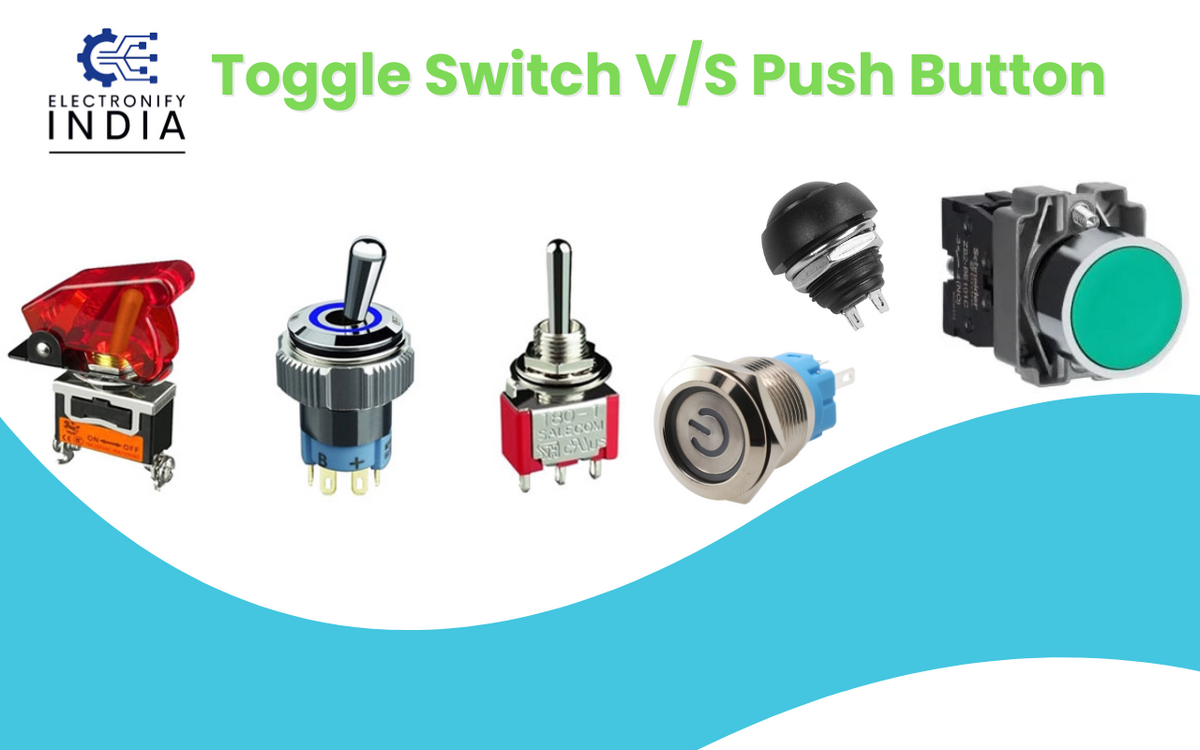Push Button vs Toggle Switch: Which one to Use?
When designing or upgrading an electrical or electronic system, one common question arises – should you use a push button or a toggle switch? Both are fundamental components in mechatronics and electronics, but choosing the right one can impact usability, durability, and functionality. In this blog, we'll break down the differences between push buttons and toggle switches to help you decide which one suits your project best.
What is the difference between a Toggle Switch and a Push Button?
When deciding between a push button and a toggle switch, understanding their differences can simplify your project. A push button activates or interrupts a circuit when pressed and returns to its original state upon release, making it ideal for momentary tasks like start/stop functions, resets, and emergency stops. On the other hand, a toggle switch maintains its ON or OFF position until manually flipped, offering clear visibility of its status and continuous control.
The main difference between a toggle switch and a push-button lies in how they operate and maintain their state:
- Toggle Switch:
- Operation: Flips between ON and OFF positions and stays in the chosen state until flipped again.
- State: Maintains its position (latching).
- Use Case: Ideal for continuous control, such as turning lights or machines on and off.
- Examples: Power switches, mode selectors, and industrial control panels.
- Push Button:
- Operation: Activates when pressed and returns to its default state when released (momentary action). Some variants (locking push buttons) stay pressed until pressed again.
- State: Temporary (unless locking type).
- Use Case: Suitable for momentary actions like starting machines, resetting systems, or triggering alarms.
- Examples: Doorbells, emergency stop buttons, and reset functions.
Explore the range at ElectronifyIndia.com for quality switches that match your needs. We offer reliable components to optimise your electronic and mechatronic designs.
What is a Push Button?
A push button is a type of switch that activates a circuit when pressed and deactivates when released (momentary) or stays in position until pressed again (locking). It is commonly used to perform simple control actions like starting or stopping machines, triggering alarms, or resetting devices.
Type of Push Buttons
Push buttons come in various types, each designed for specific applications and functionalities. The most common types include:
- Momentary Push Button: This button activates a circuit only while it is pressed. Once released, it returns to its default position, making it ideal for tasks like ringing a doorbell or resetting a device.
- Latching (Locking) Push Button: Unlike momentary buttons, latching push buttons stay in their pressed state until pressed again. This type is often used for power switches or emergency stop functions where the circuit needs to stay active or inactive until manually changed.
- Illuminated Push Button: These buttons have built-in lights that indicate the operational status. They are commonly used in control panels, helping users quickly identify if a machine or system is active.
- Emergency Stop Button (E-Stop): Designed for safety, these large, red buttons are used to immediately shut down machinery or equipment during emergencies. They are latching types and must be manually reset after activation.
- Double-Pole Push Button: This button can control two circuits at once, either by opening one circuit while closing another or performing both actions simultaneously. It is often found in industrial control systems.
Each type of push button serves a unique purpose, ensuring reliable operation and enhancing safety across various applications.
What is a Toggle Switch?
A toggle switch is a type of switch that stays in either an ON or OFF position until manually flipped. It operates by moving a lever or handle back and forth to control the flow of electricity within a circuit. Toggle switches are commonly used for applications where a stable, continuous connection is required, such as controlling lights, power tools, and industrial machinery.
One of the key advantages of toggle switches is their tactile feedback, providing a clear indication of whether a circuit is active or inactive. This makes them easy to use and visually identifiable even from a distance. Toggle switches are also known for their durability and ability to handle high currents, making them ideal for heavy-duty applications
Type of Toggle Switches
Toggle switches come in various types, each designed to meet different control and circuit requirements. Here are the most common types:
- Single Pole Single Throw (SPST): This is the simplest type, used to connect or disconnect a single circuit. It functions like a basic ON/OFF switch, commonly found in light switches and simple power controls.
- Single Pole Double Throw (SPDT): This switch can route current between two circuits. Flipping the switch changes the connection between two outputs, allowing for more complex control, such as selecting between two power sources.
- Double Pole Single Throw (DPST): This switch controls two separate circuits simultaneously but only offers a single ON and OFF position. It is often used in applications requiring the control of two independent loads at once.
- Double Pole Double Throw (DPDT): This versatile switch can control two separate circuits and toggle between two positions for each. It is used to reverse the polarity of motors or switch between different inputs and outputs.
- Momentary Toggle Switch: Unlike regular toggle switches, these return to their original position when released. They are used in applications where a temporary connection is needed, such as in starter motors.
- Locking Toggle Switch: This switch locks into position, preventing accidental flipping. It is useful in critical applications where unintended activation or deactivation could cause issues.
Each type of toggle switch is suited for specific tasks, ensuring efficient and reliable control in various electrical and electronic systems.


